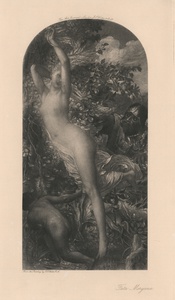| Method | Photogravure |
| Artist | after George Frederick Watts |
| Published | The Art Journal - London. J. S. Virtue & Co. Ltd. c.1889 |
| Dimensions | Image 262 x 130 mm, Sheet 325 x 243 mm |
| Notes |
A scene depicting Fata Morgana beguiling and escaping the grasp of Orlando published in The Magazine of Art. The Magazine of Art was an illustrated monthly British journal devoted to the visual arts, published from May 1878 to July 1904 in London and New York by Cassell, Petter, Galpin & Co. It included reviews of exhibitions, articles about artists and all branches of the visual arts, as well as some poetry, and was lavishly illustrated by leading engravers of the period. The subject of this print derives from Matteo Maria Boiardo's epic Renaissance work Orlando Innamorato, an incomplete cycle of poems first published in 1482. Boiardo inferred and combined various chivalric tales including those of King Arthur, Charlemagne as well as esoteric Carolingian literature. According to Boiardo's Italian text, the Fata Morgana was a malevolent fairy. She was the Queen of Avalon and half-sister of King Arthur. In the text, she owns a golden stag which attracts Brandimarte, a treasure field that tempts Ranaldo, and a fickle heart that leads her to kidnap the son of King Manodante. Above all else, Morgana was an enchantress, and Watts decides to represent her beguiling Orlando, before narrowly escaping his grasp. It is likely that the artist was familiar with William Rose's English translation of 1823, for his depiction of the subject closely mirrors Book II, Canto CLXXXIV: "Who in this world would wealth and treasure share, Honour, delight, and state, and what is best, Quick let him catch me by the lock of hair Which flutters from my forehead, and be blest; But let him not the proifered good forbear, Nor, till he seize the fleeting blessing, rest. For present loss is sought in vain to-morrow, And the deluded wretch is left in sorrow." James Dobie (1849 - 1911) was a British engraver who was born in Edinburgh, but worked on the periphery of London for a large part of his career. He was on the most part an etcher of landscape and genre scenes, and exhibited these works at the Royal Academy from 1885, until his death in 1911. He would often, but not exclusively, sign his engravings with 'J.D.' George Frederic Watts (1817 – 1904) was a popular English Victorian painter and sculptor associated with the Symbolist and Pre-Raphaelite movements. Watts became famous in his lifetime for his allegorical works, such as Hope and Love and Life. These paintings were intended to form part of an epic symbolic cycle called the 'House of Life,' in which the emotions and aspirations of life would all be represented in a universal symbolic language. His large allegorical works on universal themes appealed deeply to the Victorians, and he was considered to be the greatest English artist of his age. |
| Framing | mounted |
| Price | £100.00 |
| Stock ID | 52207 |

